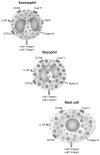Novel Therapies for Eosinophilic Disorders
- PMID: 26209901
- PMCID: PMC4515571
- DOI: 10.1016/j.iac.2015.05.007
Novel Therapies for Eosinophilic Disorders
Abstract
Current therapies for eosinophilic disorders are limited. Most treatment approaches remain empirical, are not supported by data from controlled clinical trials, involve the off-label use of agents developed for treatment of other diseases, and tend to rely heavily on the use of glucocorticoids and other agents with significant toxicity. Great progress has been made in the discovery, preclinical development, and clinical testing of a variety of biologics and small molecules that have the potential to directly or indirectly influence eosinophils, eosinophilic inflammation, and the consequences of eosinophil activation.
Keywords: Antibodies; Biomarkers; Eosinophil; Pharmacology; Targets; Therapies.
Copyright © 2015 Elsevier Inc. All rights reserved.
Figures


Similar articles
-
Mepolizumab in eosinophilic disorders.Expert Rev Clin Immunol. 2011 Jul;7(4):411-7. doi: 10.1586/eci.11.27. Expert Rev Clin Immunol. 2011. PMID: 21790283 Free PMC article. Review.
-
Anti-interleukin-5 antibody therapy in eosinophilic diseases.Pathobiology. 2005;72(6):287-92. doi: 10.1159/000091326. Pathobiology. 2005. PMID: 16582580 Review.
-
Targeted Anti-IL-5 Therapies and Future Therapeutics for Hypereosinophilic Syndrome and Rare Eosinophilic Conditions.Clin Rev Allergy Immunol. 2020 Oct;59(2):231-247. doi: 10.1007/s12016-019-08775-4. Clin Rev Allergy Immunol. 2020. PMID: 31919743 Review.
-
Treatment of hypereosinophilic syndrome and eosinophilic dermatitis with reslizumab.Ann Allergy Asthma Immunol. 2018 Jun;120(6):670-671. doi: 10.1016/j.anai.2018.02.017. Epub 2018 Feb 26. Ann Allergy Asthma Immunol. 2018. PMID: 29496465 No abstract available.
-
Eosinophilic disorders in children.Curr Allergy Asthma Rep. 2006 Nov;6(6):475-82. doi: 10.1007/s11882-006-0024-5. Curr Allergy Asthma Rep. 2006. PMID: 17026874 Review.
Cited by
-
Emerging Evidence for Pleiotropism of Eosinophils.Int J Mol Sci. 2021 Jun 30;22(13):7075. doi: 10.3390/ijms22137075. Int J Mol Sci. 2021. PMID: 34209213 Free PMC article. Review.
-
Regulation of airway inflammation by Siglec-8 and Siglec-9 sialoglycan ligand expression.Curr Opin Allergy Clin Immunol. 2016 Feb;16(1):24-30. doi: 10.1097/ACI.0000000000000234. Curr Opin Allergy Clin Immunol. 2016. PMID: 26694037 Free PMC article. Review.
-
Contributions of Eosinophils to Human Health and Disease.Annu Rev Pathol. 2020 Jan 24;15:179-209. doi: 10.1146/annurev-pathmechdis-012419-032756. Annu Rev Pathol. 2020. PMID: 31977298 Free PMC article. Review.
-
Interleukin-5 pathway inhibition in the treatment of eosinophilic respiratory disorders: evidence and unmet needs.Curr Opin Allergy Clin Immunol. 2016 Apr;16(2):186-200. doi: 10.1097/ACI.0000000000000251. Curr Opin Allergy Clin Immunol. 2016. PMID: 26859368 Free PMC article. Review.
-
Recent advances in understanding eosinophil biology.F1000Res. 2017 Jul 7;6:1084. doi: 10.12688/f1000research.11133.1. eCollection 2017. F1000Res. 2017. PMID: 28751971 Free PMC article. Review.
References
-
- Boucher RM, Gilbert-McClain L, Chowdhury B. Hypereosinophilic syndrome and mepolizumab. N Engl J Med. 2008;358:2838–9. author reply 9–40. - PubMed
Publication types
MeSH terms
Substances
Grants and funding
LinkOut - more resources
Full Text Sources
Other Literature Sources
Medical

